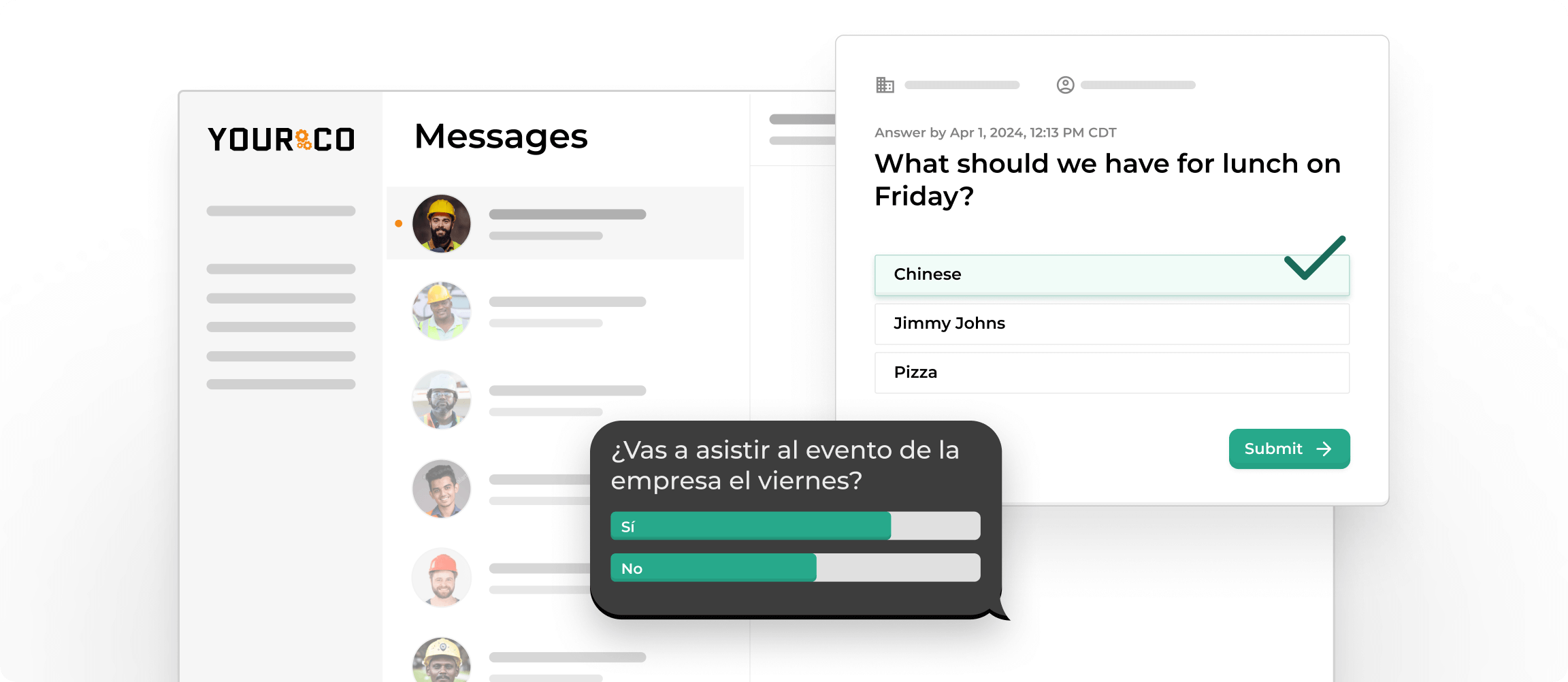Safety and Compliance Surveys: What to Ask and How to Act on Results


Think of a safety and compliance survey as an early-warning sensor embedded in your daily operations. When you ask the right questions and make it easy for every worker to answer, you uncover small hazards long before they become recordable injuries or expensive OSHA citations. These surveys also show employees that their well-being matters.
Why Safety and Compliance Surveys Matter
Safety and compliance surveys have the potential to give you advance notice of hazards before they turn into injuries, workers'-comp claims, or regulatory citations. When frontline employees flag missing guards, faulty PPE supplies, or rushed procedures, you surface risks while they're still inexpensive to fix. Similarly, for desk-workers, surveys can uncover overlooked issues like improper desk ergonomics, exposed wiring, or poor ventilation. These minor issues can lead to chronic pain, eye strain, or long-term health concerns if left unaddressed.
Regular, anonymous check-ins also show employees that you value their voice. This creates a positive cycle: as trust grows, workers volunteer more observations, and participation in broader safety initiatives rises.
Many companies find that documented survey processes help demonstrate their commitment to safety during regulatory reviews. While there are no guarantees when it comes to safety inspections, time-stamped records are often helpful, as they provide supportive documentation of your team's compliance practices.
Surveys also support continuous improvement by revealing potential gaps between written procedures and real-world practice. Tracking responses quarter over quarter can help clarify which departments are improving and where follow-up training or resources could have the biggest impact.
Consistent surveying can shift your safety program from hindsight to foresight, helping to keep everyone safer.
What Makes a Safety and Compliance Survey Effective
The key to gathering meaningful feedback lies in how you design and deliver surveys. Here’s how to make sure yours actually work, and entice employees to respond openly, quickly, and often.
- Guarantee anonymity: You only get honest answers when people feel safe speaking up. An anonymous channel removes fear of retaliation and helps you discover hazards that rarely show up in incident logs.
- Make questions reachable from a phone: For non-desk teams in construction, logistics, or manufacturing, mobile-responsive forms sent via SMS work far better than email. The same guidance stresses short, single-screen questions that fit within the 160-character limit of text messages.
- Keep the language simple and the format consistent: Replace technical jargon with plain language so a new hire on the night shift can understand the request instantly. Short sentences and consistent rating scales, such as the 1–5 formats, reduce confusion and expedite completion.
- Align with your broader safety program: Align questions with recent trainings, upcoming audits, and regulatory requirements. That alignment keeps the results actionable instead of abstract.
- Set clear objectives before drafting questions: Are you checking lockout/tagout compliance or measuring confidence in incident reporting? Tailor the survey to site-specific risks. Without that customization, you'll collect data no one can use.
- Commit to visible follow-through: Employees quickly recognize surveys that disappear into a black hole. Visible follow-through, such as new PPE stock and a revised procedure, demonstrates leadership's commitment to workplace safety.
Note that while these are best practices, every workplace is different and should be treated as such. Consider reviewing your approach with your safety officer or legal team to ensure your surveys meet both internal standards and external requirements. When done right, surveys stop being a checkbox and start becoming a real driver of safer, more compliant work.
Survey Question Categories and Examples
Many companies include these five core elements in their workplace safety and compliance surveys.
1. Safety Training Effectiveness
Start by checking whether your training actually sticks. Ask questions like:
- "On a scale of 1-5, how well did your recent safety training prepare you for the hazards in your role?"
- "Can you easily apply what you learned in training to your daily work tasks?"
Scaled questions with follow-ups help you see both how much people remember from training and how well they can use it. Low scores often mean it's time for hands-on refreshers, mentoring programs, or breaking up those long training sessions into smaller pieces.
When auditors review your program, being able to show that you periodically assess and enhance training can help address a common compliance gap. Also, when you link survey results to real changes, such as new drills, updated manuals, or materials in different languages, employees see that their feedback matters.
2. PPE Availability and Usage
Personal protective equipment only works when people have it and actually wear it. Ask your team:
- "Do you always have access to the proper personal protective equipment for your tasks?"
- "What barriers, if any, prevent you from consistently using required PPE?"
Responses reveal whether shortages, fit problems, or comfort issues keep hard hats and respirators on shelves instead of workers' heads. PPE access violations show up frequently in regulatory citations, so using surveys to spot potential gaps early can help you reduce the risk of injuries and avoid possible fines.
If answers point to supply problems, tighten inventory controls or set up grab-and-go stations near work areas. If discomfort tops the list, try different models or adjust replacement schedules. Each comment gives you direction for small fixes that prevent big problems.
3. Incident Reporting Confidence
A near miss that never reaches management is a lost chance to prevent the next accident. Check psychological safety with questions like:
- "Do you feel comfortable reporting safety concerns without fear of negative consequences?"
- "Do you know the proper procedure for reporting a near-miss or safety hazard?"
An easy-to-follow incident report template can help you boost confidence and standardize what details to capture.
Anonymity matters here. Anonymous surveys have great potential to uncover hazards that leadership never sees during walk-throughs. With Yourco, you can send anonymous surveys via SMS to employees’ phones. In that way, employees can simply tap on survey link, respond to the survey, and keep their identity protected. Also, reinforcing your non-retaliation policy by publicly thanking teams that report hazards may help to encourage employees who are hesitant to speak up.
When staff see that speaking up leads to fixes, such as better lighting in dark areas, repaired guardrails, and cleared walkways, their confidence grows, and your incident rate drops.
4. Understanding of Safety Policies
Policies sitting in binders help no one if people can't remember them on the job. Test comprehension with questions like:
- "How confident are you in knowing what to do during an emergency at your worksite?"
- "Is each safety procedure written in a way that's easy to understand and follow?"
Low confidence often points to jargon-heavy documents or one-time briefings that fade over time. Clear language and visual aids work best for mobile surveys designed for non-desk workers.
When comprehension gaps surface, you can convert dense text into step-by-step diagrams, use translation tools to translate key pages into another language, or send SMS texts with links that guide to short refresher videos near high-risk areas. Each small adjustment turns policy from paper into lived behavior.
5. Compliance with Safety Protocols
Finally, look at real-world execution. Consider asking:
- "Are lockout/tagout procedures consistently followed in your department?"
- "What obstacles prevent full compliance with safety procedures?"
Questions like these are great for revealing gaps between what managers expect and what really happens under production pressure. Findings often expose workload spikes, cumbersome steps, or missing tools — all factors that push people to take shortcuts.
Answers to compliance surveys can help you redesign workflows, spread tasks across shifts, or add visual prompts at the point of use. Then, you can follow up with spot checks and a quick pulse survey to confirm that the improvements stick. By treating compliance as a conversation rather than a mandate, you turn protocols from rules people avoid into habits they own.
When and How to Send the Survey
Understanding what to ask is only half the equation. Timing and delivery method determine whether your carefully crafted questions actually reach your workforce.
It’s a good idea to send a survey while the experience is still fresh. This gives you more time to act on feedback. With that in mind, it’s wise to send surveys at two key touchpoints:
- Immediately after onboarding or safety training
- Within 24 hours of an incident
Between these moments, CultureAmp recommends sending steady quarterly surveys. This cadence builds a trend line without overwhelming everyone.
For non-desk teams, keep in mind that it’s important to meet them where they already communicate. A simple SMS containing a mobile-friendly link reaches employees in seconds and works on any phone. Keep each questionnaire short — five to ten items that take no more than a few minutes — to respect tight schedules, avoid fatigue, and drive higher completion rates.
Before hitting send, explain why you're asking and when workers can expect to see results. Clear communication builds trust, encourages honest answers, and sets expectations that their input will spark concrete improvements.
How to Act on Survey Results
Even the best-designed survey falls flat if the feedback disappears into a black hole. To turn responses into real change, you need a clear follow-through process that builds trust, boosts participation, and actually improves safety on the floor.
Start by analyzing results through the lens of your safety program. If the survey focused on PPE access, incident reporting confidence, or comprehension of recent training, align your analysis accordingly. Sort the data by location, role, and tenure to spot trends, such as lower safety scores from new hires or specific departments. These patterns point to your highest-impact priorities.
Once you've identified issues, share the findings. Transparency matters. Employees are far more likely to respond again if they see that their feedback results in action. Keep communication simple, consistent, and accessible. A quick SMS update or a posted summary in plain language works better than long emails or technical reports.
From there, prioritize fixes based on both urgency and feasibility. A missing machine guard needs an immediate response; inconsistent shift-start safety briefings might take longer to solve. Involve frontline supervisors in this step, as they know the daily realities best and can help shape a practical action plan that gets buy-in from the ground up.
Build a simple plan for each item. Focus on these questions:
- What’s the issue?
- Who’s responsible?
- What’s the deadline?
- What resources are needed?
Make progress visible with regular updates in high-traffic areas or digital crew boards. Finally, close the loop with a quick pulse check or follow-up survey. This continuous cycle — survey, analyze, act, communicate, re-survey — turns one-off questionnaires into an embedded safety feedback system.
That follow-through is where the real impact lies. It shows your team that their input is not just collected, but respected and acted on. That’s what builds a strong, safety-first culture.
Free Safety and Compliance Survey Template
This template can serve as an assistance tool to check the pulse of your safety program. It’s built around 10 core questions that cover training retention, PPE availability, incident reporting confidence, and real-world protocol compliance — all formatted for mobile use and plain-language clarity.
You can use the survey after safety training, following an incident, or as part of your quarterly compliance checks, as an additional tool to help you surface issues. Questions are designed to work across job types: manufacturing teams can flag gaps in lockout/tagout execution, while office workers can point out overlooked hazards like poor ergonomics or blocked exits.
Customize the template for your worksite’s needs. You can add examples, tweak language for specific equipment, or insert links to refresher videos and updated safety manuals. Keep it short and send via SMS for the highest response rate across deskless teams.
→ Get the free Safety and Compliance Survey Template to start surfacing hidden risks before they become incidents. Includes ready-to-use scaled and open-ended questions, plus a built-in follow-up message to close the loop with your team.
Turn Survey Results Into Real Improvements
A single honest response on a survey can provide the insight that prevents a serious injury tomorrow. When you gather feedback consistently and act on it, you create the continuous improvement cycle that safety-management guidelines recommend. Each round of questions establishes a new baseline, showing your team that safety is an active commitment, not just a policy posted on the wall.
Yourco makes this process simple and effective. The platform delivers surveys via SMS, reaching workers — including those without email or smartphones — so more voices can be heard, even among those typically missed by traditional digital channels. You can choose to run surveys anonymously or with attribution, depending on your goals. Automatic translation to 135+ languages, short question formats, and real-time dashboards eliminate the usual barriers of low participation and confusing data. Results flow directly to the people who can take action, helping you close safety gaps quickly and keep regulators satisfied.
Want to make safety surveys part of your daily workflow? Try Yourco for free today or schedule a demo and see the difference the right workplace communication solution can make in your company.
FAQs
How often should you send safety surveys?
It depends on your operations, but quarterly surveys are most common with more targeted surveys sent right after onboarding, safety trainings, or workplace incidents. Frequent check-ins help you spot trends before they escalate.
What’s the best way to reach non-desk workers?
SMS is the most effective method. Unlike email or app-based surveys, text messages work on any phone and don’t require Wi-Fi or data. Yourco’s SMS-friendly surveys are designed to reach workers wherever they are.
Can I make surveys anonymous and still take action?
Yes. Anonymous surveys build trust and encourage honesty. You can still analyze results by location, role, or department (without revealing individual identities) to identify patterns and target interventions.
How do I get employees to take surveys seriously?
Show them that their answers lead to real changes. When workers see that survey feedback results in new equipment, clearer procedures, or better training, they’re more likely to participate next time.
What if I’m not sure how to write good survey questions?
Start with the free template provided in this guide. It covers core safety areas with clear, mobile-ready wording. You can customize it to match your industry, language needs, or current safety focus.




